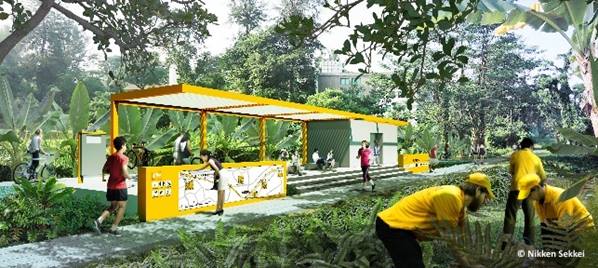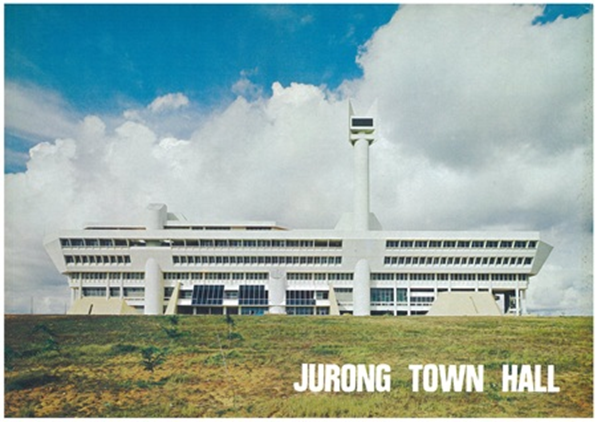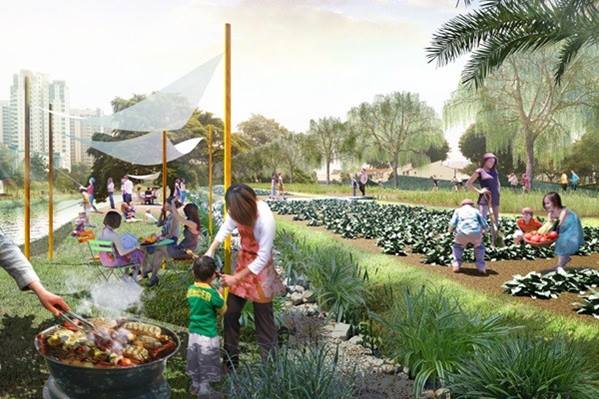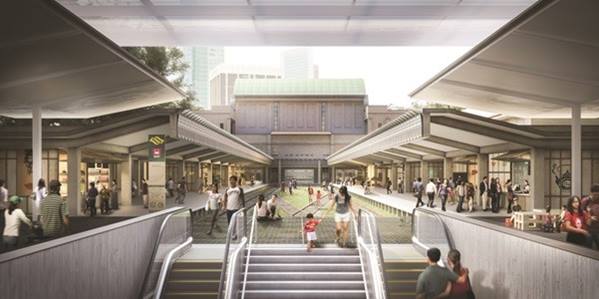Reimagining the Rail Corridor

Winners of the Rail Corridor Request for Proposal reveal a love of man and nature.
By Sarah Liu
It was a moment of great anticipation for the team that emerged top among 64 respondents at the Urban Redevelopment Authority (URA) RFP awards on 9 November. After six months of working under high stress and suspense, design professionals from Tokyo-based Nikken Sekkei and local landscape firm Tierra Design, were accorded the overall Concept Master Plan for their comprehensive and thoughtful proposal themed Lines of Life.

Awards for two special-interest sites went to another team comprising local firm MKPL Architects and Chinese landscape firm Turenscape International for its culturally sensitive proposal to reuse the former Tanjong Pagar Railway Station as a community space and vision for a 16-hectare residential precinct at Choa Chu Kang, which features mind-blowing ideas such as growing a linear forest — from scratch.
Present at the event was chairperson of the 12-member RFP evaluation panel and CEO of URA Ng Lang, who commended the teams for their overall “compelling vision” that captures a community-centred experience through “seamless connectivity” of the Rail Corridor and their “respect [of] and sensitivity to the area’s rich ecology and heritage”.

Creative programming of community events from the ground up … to “accommodate the evolving needs of the community”.
A serene sanctuary
The idea behind Lines of Life is, as you might expect, somewhat poetic. It reimagines the former railway track as a green community ‘lifeline’ or sanctuary away from the brouhaha of the concrete environment.

“Compared to Tokyo, Singapore is so green. But the Corridor itself is even greener, quieter, more peaceful and very different from the built-up environment. We really wanted to retain that kind of feel, so that we don’t transform it into something completely different,” explains Shoji Kaneko, Urban Designer and Landscape Architect at Nikken Sekkei.
To achieve that, the team will need tact and sensitivity to nature. While they plan to introduce more diverse vegetation to the terrain and enhancing the area’s biodiversity, more importantly, they advocate subtle development through smart design, at the more ecologically-delicate spots close to the Bukit Timah Fire Station. “We want to introduce a deck so that it’s above the ground, allowing access, but not a disturbance of the growth areas,” says Taku Suzuki, who specialises in landscape design at Nikken Sekkei. “People will go through the Corridor on an elevated walkway, so the greenery that goes under or over it can be left untouched,” adds Kaneko.

Going beyond a jogging or cycling track, the Japan-Singapore team felt a need to incorporate a complex and rich source of lifestyle activities for all to enjoy. Combining entertainment with eco and even agricultural activities, people may be able to watch outdoor movies, practice yoga at available decks, or even cultivate their own food at community farming plots. Eight key ‘activity nodes’ are situated in areas including Buona Vista, Mayfair Park (near Rifle Range Road), the former Bukit Timah Fire Station and the Kranji MRT vicinity.
A new journey
Winners of the adaptive reuse of the Tanjong Pagar Railway Station offer another viewpoint on the Rail Corridor: a new journey in the history of commuting in Singapore. Proposed blueprints of the Circle Line Cantonment MRT Station will see the construction of the station at the periphery of the historic terminus.
But the team didn’t let plans fetter them. Instead, they boldly proposed the integration of a new entrance or exit along the tracks. To the Singapore-China team, the fusion of the old and new gives birth to a fresh perspective on experiencing embarkation, departure and arrival at a destination.

“The idea comes from a simple, romantic notion that every time we go to the train station, it’s to embark on a journey — arriving and departing. We want to bring back the memory of the old platforms through a new ‘invention’ using metal gratings that allows you to look at the ground, a bit like an archeological site, and see the original tracks and also allows grass to organically grow through,” says Siew Man Kok, Director of local firm MKPL Architects.
His team also proposed for the existing car park to be turned into an open lawn, allowing for creative programming of community events from the ground up, resonating strongly with the RFP’s brief to “accommodate the evolving needs of the community”.
Growing residences
Man Kok’s team is driven by a philosophy he explains as a “light touch and an invisible hand”. Aside from using it to retain the original charm of the terminus, this philosophy also drives their Living in the Forest proposal for the residential district at Choa Chu Kang. The success of the philosophy, Man Kok explains, hinges on developing slowly, over time. The current site is logged and barren, and to integrate this constituent neighbourhood as a part of the whole railway track, the team suggests a tremendous feat to reintroduce the ‘rustic feel and greenery’ to the Corridor: grow a forest.
“When you buy a unit, you will, in a way, be growing up with the forest. Our estimation is that maybe in 20 to 30 years when we can get the trees to a certain height, it can really create a sense of rootedness for the people staying there. You see the old lady in the picture? I always say ah, that she’s lived there for 60 years. Because to get the trees to be that tall, that’s about the time it takes,” Siew says with a laugh.
In an unconventional, even intrepid stroke of creativity, the design of the residential blocks are positioned to engage with the varying heights of the trees, whose growth are ‘timed’ to follow the ascent of the proposed buildings. While he acknowledges the importance of the Master Plan in stitching the social dimensions of the Corridor, Raymond Woo, evaluation panel member and Principal Architect with Raymond Woo and Associates, says that this residential proposal is his favourite proposed section of the Corridor.

“It is a daring scheme that allows residents at all blocks and levels to enjoy the linear forest, with sky bridges for those on the higher floors and communal farming decks for the lower floors. The integration of Pang Sua Canal as part of the public realm also complements the mid to high-rise ‘forest neighbourhoods’ to create an extremely pleasant environment,” he comments.
A social brocade
For land-scarce Singapore, this uninterrupted 24-kilometre stretch is what Ng describes as “a very rare, and prominent space that goes from north to south of Singapore”. Needing careful deliberation, the URA emphasises that they are in no hurry to develop it. In the next year, they will be seeking community inputs to further shape the plan and refine the corridor into something unique for Singaporeans.
Unlike few uses that many parks worldwide offer, the judges perceive the Corridor as a social brocade in the ever-changing Singapore fabric. “There are many things that will be developed in the future for recreation, industry, housing. And it’s quite different from what the other countries have, like the Central Park of New York, Hyde Park of London — those are quite static. But this is going to be dynamic, a track that shall continue to grow,” says Raymond, capturing the panel’s sentiments.
This article was originally published on
Going Places Singapore on 13 Nov 2015






